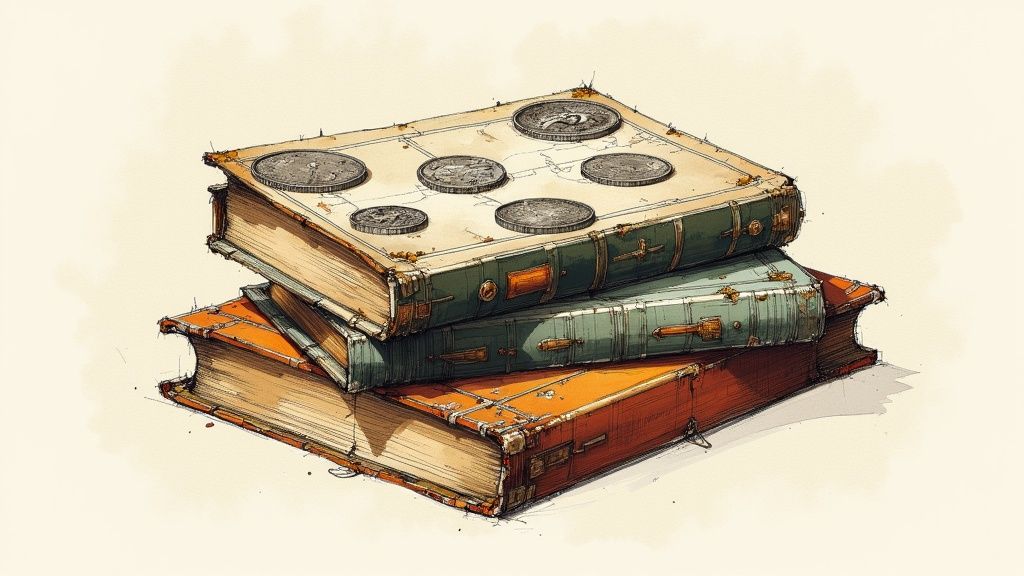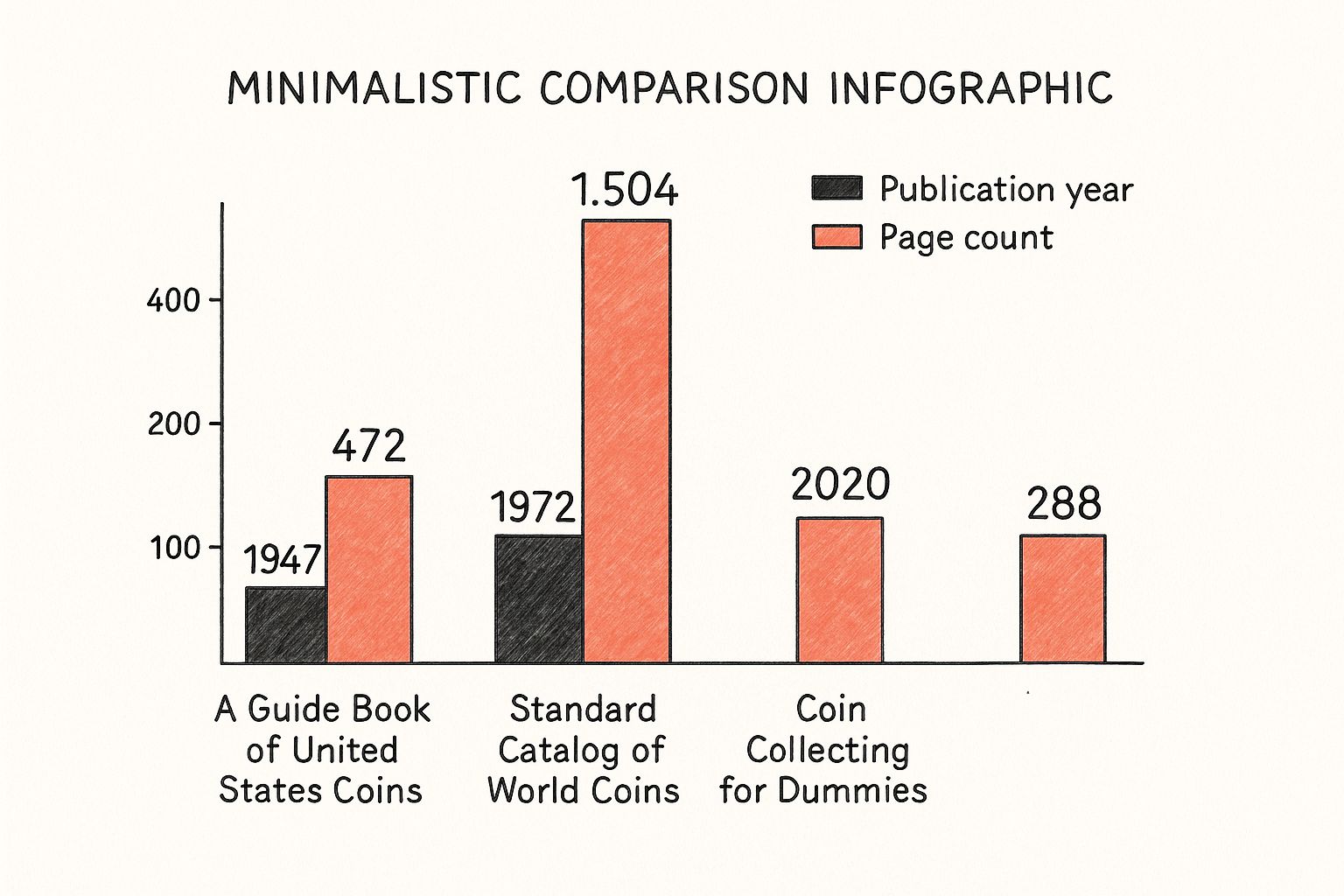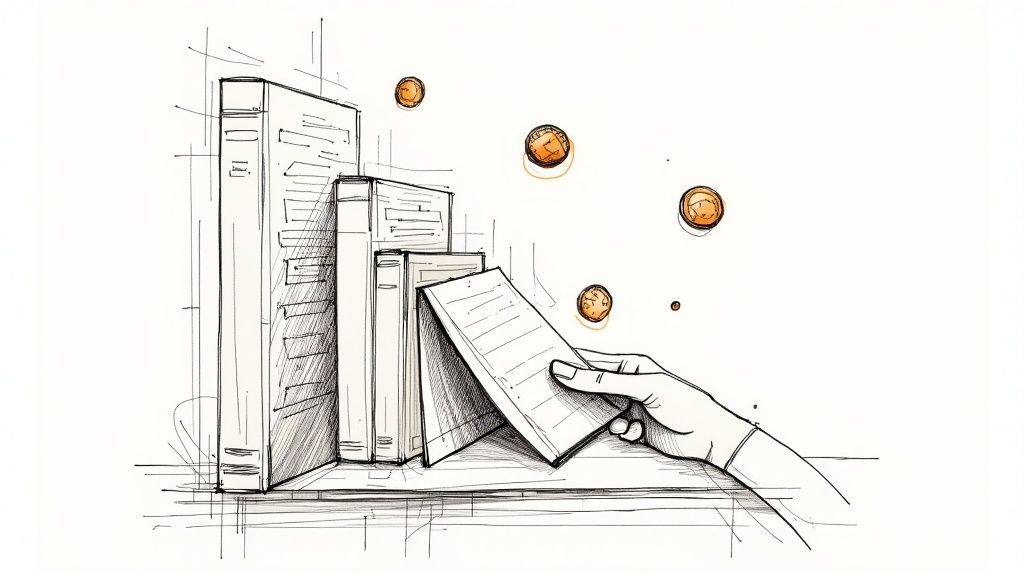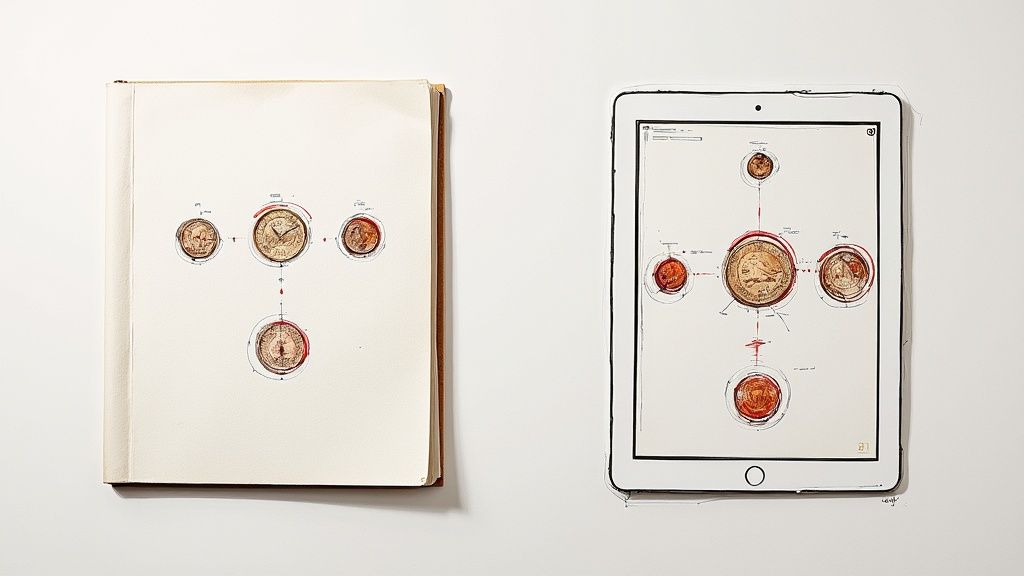Starting a coin collection is like opening a history book where every page is made of metal. But where do you even begin? I'll tell you the single most valuable tool for any numismatist, new or old: a solid library of quality books on coins. These aren't just books; they're your mentors in print, helping you sidestep costly mistakes and truly appreciate the art and story stamped into every piece you hold.
Why a Book Collection Is Your Greatest Asset

Jumping into numismatics without the right books is like setting sail without a map and compass. Sure, the internet is a vast sea of information, but physical books give you a structured, authoritative foundation that a quick online search just can't match. A carefully chosen library is what turns a casual hobby into a real, informed passion.
Think of it this way: a coin is a tangible piece of history, but its story is silent until you find the key to unlock it. Books are those keys. They give you the context, the hard data, and the expert analysis you need to understand what’s in your hand, where it came from, and what makes it special.
The Core Pillars of a Numismatic Library
You won't build your reference collection overnight. It’s a process that begins with understanding the main types of numismatic books and what each one is for. Every category offers a unique lens for viewing your collection.
A strong library is usually built on these cornerstones:
- Catalogues and Identification Guides: These are the encyclopaedias of the coin world. They’re packed with detailed specs, mintage figures, and photos to help you identify every coin with confidence.
- Price and Value Guides: Think of these as your market compass. They provide up-to-date valuation data, helping you grasp the commercial worth of your coins and make smarter buys.
- Historical Volumes: These books are the storytellers. They delve into the economic, political, and cultural worlds that a coin was born into, bringing the metal to life.
A curated selection of books empowers you to make informed decisions, whether you're attributing a rare find, assessing its condition, or deciding on your next acquisition. It is the bedrock of confident collecting.
From Information to Expertise
Ultimately, the goal of building a numismatic library isn't just to hoard information—it's to develop genuine expertise. The right books teach you to spot subtle variations, understand the nuances of grading, and identify counterfeits. These are the skills that separate the seasoned collectors from the beginners.
As you grow in the hobby, your library will grow with you. You'll move from introductory guides to highly specialised books on your niche interests. This journey of learning is, for many of us, one of the most rewarding parts of collecting. To get a head start on building your own essential collection, our guide on the top coin collecting books to boost your numismatics knowledge is an excellent place to begin.
Decoding the Different Types of Coin Books
Diving into the world of books on coins can feel a bit like stepping into a massive library for the first time. There are countless aisles, and not all books are created equal. The key is knowing which one to pull off the shelf, and that choice depends entirely on what you’re trying to accomplish at that moment.
Think of your numismatic library as a specialist team, with each book playing a unique role. A catalogue is your meticulous 'cartographer,' mapping every known detail of a coin's existence. A price guide is the 'financial analyst,' crunching the latest market data. And historical texts? They're the 'biographers,' bringing the rich stories behind the metal to life.
Let's break down these essential categories so you know exactly which expert to call on.
The Catalogue: Your Indispensable Map
The absolute cornerstone of any serious numismatic library is the catalogue. This is your comprehensive, systematic listing of coins from a specific country, region, or time period. Its number one job is identification. Plain and simple.
A good catalogue is packed with essential data for every coin listed:
- Detailed Descriptions: It notes everything from the monarch and denomination to the specific design elements.
- Mintage Figures: This tells you exactly how many coins were produced, a crucial clue to its rarity.
- Known Varieties: It highlights those subtle but vital differences—like die variations or mint marks—that can completely change a coin's story and value.
For anyone collecting UK coins, the annual Coins of England & The United Kingdom (known to most of us simply as 'Spink') is the bible. It works as a detailed map, letting you pinpoint precisely which coin you're holding, where it fits in history, and what makes it special.
The Price Guide: Your Market Report
While a catalogue identifies a coin, a price guide evaluates it. These books are all about the commercial value, providing estimated prices based on a coin's grade or condition. It’s like a stock market report for numismatics, reflecting current collector demand and the latest auction results.
Price guides are almost always updated annually because the market is constantly moving. A coin worth £100 last year might fetch £150 this year after a surge in popularity or new research affecting its rarity. Relying on an old price guide is like using last year's financial pages to make today's investments—the information is simply out of date.
This brief infographic shows just how substantial and frequently updated these key reference books are.

As you can see, the major guides aren't just weighty volumes; they are regularly revised to give collectors the most current information possible.
Historical Texts: The Storytellers
Finally, we have the historical and specialised books. These are the ones that provide the rich narrative, transforming a simple piece of metal into a tangible historical artefact. They are the biographies of your coins, exploring why they were made, the economic climate of the time, and the political messages they were designed to carry.
These books answer the "why" behind your collection. Why does this Roman coin feature that specific emperor? Why did the design of the British penny change so dramatically in one particular decade?
Reading these texts connects your collection to the grand sweep of history. You're no longer just a collector; you become a custodian of stories, gaining a deep understanding of the world in which your coins once circulated. They are absolutely essential for taking your passion beyond simple identification and valuation.
To make it even clearer, here’s a quick breakdown of which book to reach for depending on your goal.
Choosing the Right Numismatic Book for Your Goal
| Book Type | Primary Purpose | Best For | Example Use Case |
|---|---|---|---|
| Catalogue | Identification & Attribution | Collectors at all levels needing to confirm a coin’s details. | You find an old coin and need to know its mintage, monarch, and any known varieties. |
| Price Guide | Valuation & Market Analysis | Buyers, sellers, and anyone looking to understand the current market value of their collection. | You're thinking of selling a graded coin and want a recent estimate of its worth. |
| Historical Text | Context & Deeper Understanding | Enthusiasts who want to know the stories behind the coins. | You want to understand the political reasons for a change in coinage during the Tudor period. |
Ultimately, a well-rounded library with a mix of these types will give you the knowledge and confidence to build a truly meaningful collection.
How Books Reveal the History of UK Coinage

Collecting UK coins is like taking a walk through our nation’s complex history, and specialised books on coins are your travel guide. While a simple catalogue can tell you what a coin is, a good historical text explains why it exists in the first place. These books transform your collection from an assembly of metal discs into a personal museum of artefacts, each with its own story to tell.
When you start reading, you learn to see your coins as primary historical sources. They're direct, tangible links to the economic struggles, political dramas, and cultural values of the British Isles. A tiny change in a coin's metallic composition, for instance, might point to a period of economic hardship or a wartime shortage of precious metals.
These scholarly works are the academic bedrock of the hobby, preserving and interpreting the long story of UK money. They give you the context you need to truly understand and appreciate what you’re holding.
From Metal to Manuscript
The study of coinage—numismatics—relies heavily on published research to build a shared body of knowledge. Without it, every collector would have to start from scratch. Books are the bridges connecting generations of researchers, preserving their findings and making them accessible to everyone.
Major institutions have played a huge role in this. The Royal Numismatic Society, for example, founded in London in the 19th century, was key to developing the scholarly study of British coinage. Its publications, from 1861 onwards, systematically documented everything from Roman Britain to modern currency, with a special focus on hoard discoveries that provide priceless data. You can discover more about the society's historical impact on its website.
This academic tradition means that when you read about a specific mint mark or design element, you're benefiting from decades, sometimes centuries, of careful analysis and debate.
Books are where raw data from archaeological finds and private collections is transformed into coherent historical narratives. They connect your individual coin to the bigger picture of our national story.
Uncovering Stories in the Details
So, how exactly do these books bring the past to life? They teach you to spot the small details that might otherwise go unnoticed. A well-researched text will walk you through the key features that tell a much deeper story.
- Mint Marks: These tiny symbols reveal where a coin was struck, linking it directly to a specific city and its regional economy during a particular era.
- Design Changes: A new portrait of a monarch or a shift in heraldic symbols can signal major political events, like a change in dynasty or the union of kingdoms.
- Hoard Analysis: Books that analyse coin hoards offer invaluable snapshots of the currency circulating at the very moment the coins were buried, often during times of war or instability.
By learning to read these clues, you'll start to appreciate the immense depth of information your collection holds. You can begin to understand the economic pressures of the Norman Conquest or the political messaging of the Reformation, all through the coins in your hand. For a deeper dive, explore our article covering a brief history of British coins.
Using Books to Identify and Catalogue Your Collection
A good reference book can be the difference between a shoebox full of odd coins and a structured, valuable collection. Think of a numismatic catalogue as your Rosetta Stone—it gives you the keys to unlock a coin's story by translating its symbols, portraits, and inscriptions. It’s this process that elevates a simple hobby into a serious, organised pursuit.
The first, most crucial step is matching a coin in your hand to its entry in a comprehensive catalogue, like Spink's Coins of England & The United Kingdom. By carefully comparing your coin to the detailed listings and high-quality images, you can start to pin down exactly what you have. This is the cornerstone of proper cataloguing.
Pinpointing Your Coin's Identity
The real detective work starts here. A quality catalogue won't just show you a picture; it'll guide you through the process, training your eye to spot the tiny details that most people would miss.
You'll need to focus on identifying these core features:
- Monarch and Date: Who issued the coin, and when? This establishes its place in history.
- Denomination: Was it a shilling, a groat, or a sovereign? Knowing its original value is key.
- Mint Mark: A tiny symbol that tells you where the coin was struck. This can have a huge impact on its rarity.
- Key Variations: Spotting the small but vital differences in design or text that separate a common coin from a rare variety.
Getting these features right is the foundation of building a detailed inventory of your collection. If you want a deeper dive into creating one, be sure to check out our guide on how to catalogue your coins effectively.
Advanced Classification for Ancient Coins
When you get into certain areas, like ancient coinage, the books become even more specialised. For Roman coins, for example, experts have developed systematic classification schemes to bring a sense of order to centuries of complex monetary history. It's this level of detail that allows us to understand archaeological finds with incredible precision.
A systematic approach, guided by scholarly books, empowers you to move beyond basic identification. You begin to understand your coins' true historical context, placing them within the broader narrative of economic and political change.
A brilliant example of this in action is the use of 'Reece periods' in British archaeology. Numismatic studies focusing on Roman coins found in England and Wales have built up a massive database of over 490,000 coin finds. These have been systematically analysed using Reece periods—a framework that divides Roman coinage into distinct chronological phases from before AD 41 right through to the fifth century. Learn more about the research into this vast corpus of Roman coins.
This methodical approach, laid out in specialised books on coins, allows both collectors and historians to date archaeological sites and trace monetary patterns with remarkable accuracy. It’s a perfect illustration of how the right book provides the framework to turn a simple find into a documented piece of history.
Discovering Key UK Numismatic Institutions
If you want to truly get to grips with coin collecting, it helps to know where the experts go for their information. In the UK, a few key institutions are the absolute bedrock of numismatic research, and their work provides the raw material for many of the best books on coins. Getting to know these organisations is the first step in spotting a quality resource.
The giant in this field is, without a doubt, the British Museum. Its Department of Coins and Medals isn’t just a dusty old collection; it’s the definitive reference library for British and world coinage. The research that happens here, and the exhibitions they put on, directly influence the knowledge available to all of us. This is where the hard data that fills our catalogues and history books comes from.
The British Museum: A National Treasure Trove
It’s hard to overstate the scale of the British Museum’s collection. Established as its own department back in 1860-1, it now holds the UK's largest numismatic collection—we're talking nearly one million items, with some dating all the way back to the 7th century BC.
While only around 9,000 of these incredible artefacts are on permanent display, the entire collection serves as the foundation for ongoing academic study. You can read more about the department's extensive holdings on their official page.
This image shows the layout of the Citi Money Gallery, where you can see a good chunk of the collection for yourself.

The museum organises its displays to tell the story of money, which makes the often-complex history of coins far more accessible to everyone. For any collector, having access to this, whether in person or online, is an absolute goldmine.
How These Institutions Shape Your Bookshelf
So, what does this all mean for the books you buy? Simple. When you see a book that cites research from the British Museum or The Royal Numismatic Society, you know you’re holding something credible. These are the places where new discoveries are verified, ancient hoards are analysed, and the official history of coinage is written.
The publications from these bodies are the vital link between priceless national treasures locked in a vault and the book sitting on your shelf. They translate dense academic work into something every collector can understand and enjoy.
Once you know who the key players are, you’ll start to spot the signs of a trustworthy book. Look for authors affiliated with these institutions, or check the acknowledgements and citations. It’s a simple check that ensures the books you spend your money on are built on a solid foundation of real expertise, helping you build a library that’s both reliable and genuinely fascinating.
Matching Your Books to Your Collecting Level
Your numismatic library shouldn't be a static, one-and-done purchase. Think of it as a living collection that needs to grow and change right alongside your expertise. A collector's bookshelf should tell the story of their journey, just like the coins themselves. Picking the right books on coins for where you are right now is the key to making real progress and, just as importantly, enjoying the process.
It’s easy to get this wrong. A beginner wrestling with a dense academic volume is a bit like a new driver trying to handle a Formula 1 car – it’s just overwhelming and you won't get very far. The trick is to start with books that build your confidence and make the basics crystal clear.
For the New Collector
When you're just starting out, your first job is simply to learn the language. You need books that clearly explain grading, break down numismatic terms, and help you identify common UK coins without any fuss. Introductory guides are your absolute best friends here. They'll give you a solid grounding in what you need to know, saving the obscure details for later.
You should be on the lookout for titles that have:
- Clear pictures to help you spot key features on a coin.
- Simple explanations of core ideas like a coin's condition and its rarity.
- Broad overviews of the main periods in British coinage history.
Your first few books are your toolkit for understanding the hobby. You're not trying to build an exhaustive encyclopaedia just yet. The goal is to lay a strong foundation before you start building your knowledge sky-high.
For the Intermediate Enthusiast
Once you're at the point where you can confidently identify and grade the coins you find, it's time to start drilling down. This is where the real fun begins. Intermediate collectors should be looking for more detailed catalogues and price guides that focus on their specific interests, whether that's hammered coinage or the pennies of the Victorian era.
These are the books that help you explore the tiny, fascinating details within your chosen field. You’ll start to spot minor variations, understand what makes one coin more valuable than another, and learn about the market forces at play. At this stage, your library stops being about general instruction and becomes a set of targeted research tools. Your bookshelf truly starts to reflect your own unique passions as a collector.
Common Questions About Coin Collecting Books
Diving into the world of numismatic books can feel a bit overwhelming, especially when you're just starting to build your reference library. It's only natural to have a few questions.
Getting clear answers is the key to investing your money wisely and making sure you buy the resources that will actually help you with your collection. Let's tackle some of the most common queries collectors have about books on coins.
What Is the Best Coin Price Guide Book?
If you're collecting British coins, the one you'll see on almost every shelf is the annual Coins of England & The United Kingdom—often just called Spink. It’s the industry standard for a reason: it's comprehensive, respected, and has been around for decades. For US coins, the equivalent is A Guide Book of United States Coins, better known as the Red Book.
Ultimately, though, the "best" guide is the one that matches your specific collecting interests. Always choose the book that covers the coins you own or are hunting for.
Keep in mind that price guides are just a snapshot in time. To get the most accurate feel for value, especially if you're buying or selling, you absolutely need the most recent edition. Relying on an old guide is a recipe for costly mistakes.
Are Digital or Physical Coin Books Better?
This is a classic debate, and the truth is, both have their place. Many serious collectors I know actually use a mix of the two. It really boils down to your personal preference and what you're trying to do.
- Physical Books: There's nothing quite like a physical book for deep study and building a permanent library you can always turn to. They don’t need charging and offer that tactile experience of flipping through pages while examining a coin up close.
- Digital Books: The big wins here are portability and searchability. Need to look up a specific variety on the go? A digital version on your tablet is brilliant for that. They can also be updated more easily than a printed book.
How Often Are Coin Collecting Books Updated?
It really depends on the type of book. Price guides must be current, so they are almost always updated every single year to keep up with the latest market trends and auction prices.
Catalogues and historical reference books, on the other hand, have a much longer shelf life. A new edition might only come out when major discoveries are made or enough new research comes to light to change what we know about a particular area of numismatics.
At Cavalier Coins Ltd, we stock a huge range of coins and banknotes for collectors at every level. You can explore our curated collections and find the next centrepiece for your display at https://www.cavaliercoins.com.

